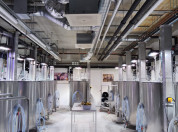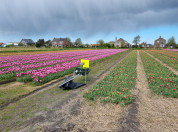Research facilities
There are many ecological research facilities at NIOO: from experimental mini-ponds to research vessels, and from living labs to bacterial culture collections.
Filter by
Infrastructure type
Landscape type
Active filters
Search results
-
Hole-breeding passerines monitoring: Hoge Veluwe
Hoge Veluwe is one of four areas in NIOO-AnE's long-term monitoring research on great tits and other bird species that started in 1955. It consists of a large forest area of more than 350 ha of mainly conifers and oak on poor sandy soil. This area is part of the largest forest complex in the Netherlands, De Veluwe. Every breeding season, many students and researchers are involved in doing field work at Hoge Veluwe. -
Hole-breeding passerines monitoring: Liesbos
Liesbos is one of four areas in NIOO-AnE's long-term monitoring research on great tits and other bird species that started in 1955. It consists of a large forest area of about 100 ha of deciduous trees, mainly oak, on rich sandy-loam soil.
-
Hole-breeding passerines monitoring: Oosterhout
Oosterhout is the last of four areas in NIOO-AnE's long-term monitoring research on great tits and other bird species. Research there started in 1956, one year after the other three areas. It consists of deciduous forest of mainly oak trees on a country estate of about 8 ha, and has a rich clay-sandy-loam soil. Oosterhout has around 150 nestboxes.
-
Hole-breeding passerines monitoring: Vlieland
Vlieland is one of four areas in NIOO-AnE's long-term monitoring research on great tits and other bird species that started in 1955. It consists of several smaller forest areas, which together cover about 250 ha of mainly conifers and oak on poor sandy soil. As Vlieland is an island in the Wadden Sea, the area stands completely on its own. Important population questions in NIOO's long term research are/were studied here.
-
Land van Ons - Warmond
The foundation 'Land van Ons' has obtained a peat meadow area near Leiden to increase biodiversity in this intensively used agricultural area. The goal is not to recreate nature, but to develop sustainable agricultural use of this land with the goal of increasing biodiversity in the area and developing management strategies that optimise its ecological, economic and recreational value.
-
Limnotrons
The limnotrons are twelve stainless steel indoor mesocosms with a high level of control. The dimensions are: 0.97 m in diameter, 1.32 m (side) and 1.37 m (centre) depth, and a maximum volume of 922 L. In addition to the possibility of sampling vertically with specifically designed integrated water samplers, sampling can also be done by using the sampling ports positioned at three depths. The vessels are equipped with automatic sensors (oxygen, temperature, light), which can make pre-programmed depth profiles.
-
Living Lab B7
The aim of Living Lab B7 is best summarised as providing insights and KPI’s (critical performance indicators) to Greenport Duin- and Bollenstreek, Nationaal Park Hollandse Duinen and the Deltaplan Biodiversiteitsherstel to contribute to the practice of biodiversity recovery in rural areas on local, regional and national scales.
-
LTER-LIFE: a research infrastructure to develop Digital Twins of ecosystems in a changing world
The LTER-LIFE lab allows building digital twins (digital replicas) of ecosystems. With these twins, scenarios can be constructed to understand how ecosystems respond to pressures in order to develop effective response strategies. LTER-LIFE will initially focus on 2 of the most extensive and best-studied ecosystems in the Netherlands representing aquatic and terrestrial ecosystems: the Wadden Sea and the Veluwe.
-
LTSER-platform Dutch Wadden Sea
The Long-Term Socio-Ecological research platform Dutch Wadden Sea area is a large coastal area bordering the north of the Netherlands.
-
Marker Wadden
The Marker Wadden is a newly constructed archipelago in lake Markermeer, which aims to improve the lake’s degrading food web by stimulating primary productivity. The archipelago consists of five islands that add a currently missing habitat type to the lake: shallow, sheltered waters with high nutrient availability and gradual land-water transitions.
-
Mesocosms for soil-plant-insect interactions
A total of 40 mesocosms are distributed in five rows of eight mesocosms with a spacing of 0.5 m between them. In spring/summer we grow plant species that are currently expanding their range within Europe and species that belong to the same genus while being native in the Netherlands.
-
Microcosms
The Netherlands Institute of Ecology (NIOO-KNAW) houses 36x10L microcosms (transparent polycarbonate carboys; NALGENE, Rochester, USA) for plankton research. The microcosms can be temperature-controlled in water baths (at 0.5 °C temperature resolution), and automatically stirred through magnetic stirrers mounted below the water baths.
